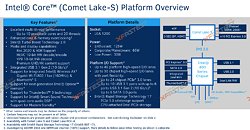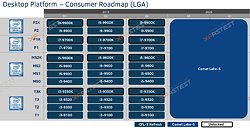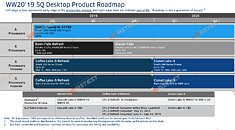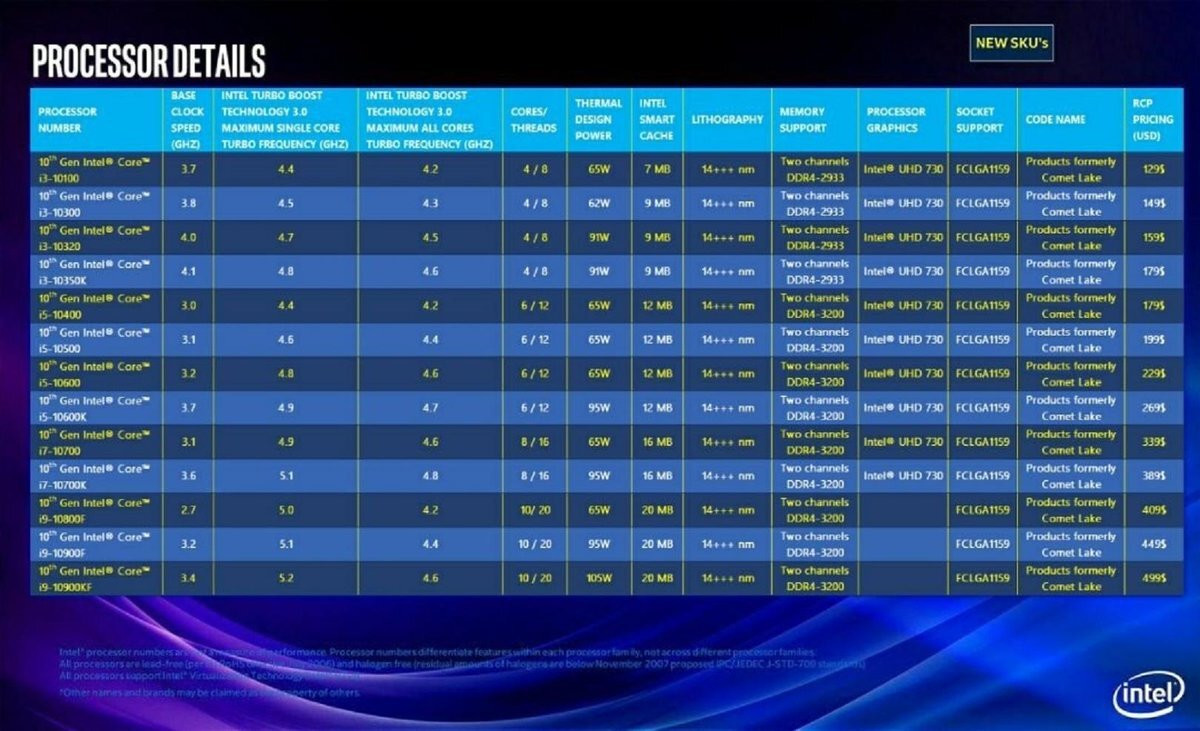- Joined
- Oct 9, 2007
- Messages
- 47,233 (7.55/day)
- Location
- Hyderabad, India
| System Name | RBMK-1000 |
|---|---|
| Processor | AMD Ryzen 7 5700G |
| Motherboard | ASUS ROG Strix B450-E Gaming |
| Cooling | DeepCool Gammax L240 V2 |
| Memory | 2x 8GB G.Skill Sniper X |
| Video Card(s) | Palit GeForce RTX 2080 SUPER GameRock |
| Storage | Western Digital Black NVMe 512GB |
| Display(s) | BenQ 1440p 60 Hz 27-inch |
| Case | Corsair Carbide 100R |
| Audio Device(s) | ASUS SupremeFX S1220A |
| Power Supply | Cooler Master MWE Gold 650W |
| Mouse | ASUS ROG Strix Impact |
| Keyboard | Gamdias Hermes E2 |
| Software | Windows 11 Pro |
Earlier this week, news of Intel's 10th generation Core "Comet Lake" processors did rounds as the company's short-term response to AMD's 3rd generation Ryzen processors. According to slides leaked to the web by Hong Kong-based tech publication XFastest, "Comet Lake" isn't Intel's short-term reaction to "Zen 2," but rather all it has left to launch. These processors won't launch before 2020, the slide suggests, meaning that AMD will enjoy a free rein over the processor market until the turn of the year, including the all-important Holday shopping season.
More importantly, the slide suggests that "Comet Lake" will have a market presence spanning Q1 and Q2 2020, meaning that the 10 nm "Ice Lake" won't arrive on the desktop platform until at least Q3 2020. It's likely that the LGA1200 platform which debuts with "Comet Lake" will extend to "Ice Lake," so consumers aren't forced to buy a new motherboard within a span of six months. The platform diagram put out in another slide junks the idea of an on-package MCM of the processor and PCH dies (which was likely ripped off from the "Ice Lake-Y" MCM platform diagram).



The new platform combines a "Comet Lake" processor with an Intel 400-series PCH, which talk to each other over DMI 3.0, which offers comparable bandwidth PCI-Express 3.0 x4. The AMD "Valhalla" platform implements PCI-Express 4.0 x4 between the SoC and X570 chipset. The platform's main PCI-Express x16 slot will remain gen 3.0.
Intel appears to have put much of its efforts into improving its 14 nanometer node one last time, and increasing core-counts with the introduction of a new 10-core silicon that does away with iGPU. With its "Skylake" core IPC within 5% of that of "Zen 2," and gaming performance leadership still held onto by a hair's breadth, Intel will focus on bolstering multi-thread performance by enabling HyperThreading on even its Core i5 and Core i3 desktop processor models, while providing more cores to the Dollar compared to its 9th generation "Coffee Lake Refresh."
The Core i3 series will be 4-core/8-thread, the Core i5 series 6-core/12-thread, the Core i7 series 8-core/16-thread, and the flagship Core i9 series 10-core/20-thread. Intel will leverage its refined 14 nm node to increase clock-speeds across the board, with its 10-core silicon having a TDP rating of 125 W, and not the 105 W we saw the other day. The Gen 9.5 iGPU on the 4/6/8-core models will be bolstered with more features via software, and be branded under the UHD 700-series.
With its mainstream desktop platform embattled, Intel will try to appease the PC enthusiast crowd by launching a new HEDT (high-end desktop) platform based on "Cascade Lake," codenamed "Glacial Falls," by Q4-2019. The new 14 nm "Cascade Lake-X" processor will be compatible with existing X299 chipset motherboards via a BIOS update, offer CPU core-counts of up to 18, TDP of up to 165 W, and increased performance via higher clock-speeds. It will compete with AMD's existing 2nd generation Ryzen Threadripper family. AMD's plans for a 3rd generation Threadripper based on the "Rome" MCM is on the back-burner even if not dead, with the company focusing on making sure it sells the high-margin 2nd generation EPYC processor in adequate volumes.
View at TechPowerUp Main Site
More importantly, the slide suggests that "Comet Lake" will have a market presence spanning Q1 and Q2 2020, meaning that the 10 nm "Ice Lake" won't arrive on the desktop platform until at least Q3 2020. It's likely that the LGA1200 platform which debuts with "Comet Lake" will extend to "Ice Lake," so consumers aren't forced to buy a new motherboard within a span of six months. The platform diagram put out in another slide junks the idea of an on-package MCM of the processor and PCH dies (which was likely ripped off from the "Ice Lake-Y" MCM platform diagram).



The new platform combines a "Comet Lake" processor with an Intel 400-series PCH, which talk to each other over DMI 3.0, which offers comparable bandwidth PCI-Express 3.0 x4. The AMD "Valhalla" platform implements PCI-Express 4.0 x4 between the SoC and X570 chipset. The platform's main PCI-Express x16 slot will remain gen 3.0.
Intel appears to have put much of its efforts into improving its 14 nanometer node one last time, and increasing core-counts with the introduction of a new 10-core silicon that does away with iGPU. With its "Skylake" core IPC within 5% of that of "Zen 2," and gaming performance leadership still held onto by a hair's breadth, Intel will focus on bolstering multi-thread performance by enabling HyperThreading on even its Core i5 and Core i3 desktop processor models, while providing more cores to the Dollar compared to its 9th generation "Coffee Lake Refresh."
The Core i3 series will be 4-core/8-thread, the Core i5 series 6-core/12-thread, the Core i7 series 8-core/16-thread, and the flagship Core i9 series 10-core/20-thread. Intel will leverage its refined 14 nm node to increase clock-speeds across the board, with its 10-core silicon having a TDP rating of 125 W, and not the 105 W we saw the other day. The Gen 9.5 iGPU on the 4/6/8-core models will be bolstered with more features via software, and be branded under the UHD 700-series.
With its mainstream desktop platform embattled, Intel will try to appease the PC enthusiast crowd by launching a new HEDT (high-end desktop) platform based on "Cascade Lake," codenamed "Glacial Falls," by Q4-2019. The new 14 nm "Cascade Lake-X" processor will be compatible with existing X299 chipset motherboards via a BIOS update, offer CPU core-counts of up to 18, TDP of up to 165 W, and increased performance via higher clock-speeds. It will compete with AMD's existing 2nd generation Ryzen Threadripper family. AMD's plans for a 3rd generation Threadripper based on the "Rome" MCM is on the back-burner even if not dead, with the company focusing on making sure it sells the high-margin 2nd generation EPYC processor in adequate volumes.
View at TechPowerUp Main Site






